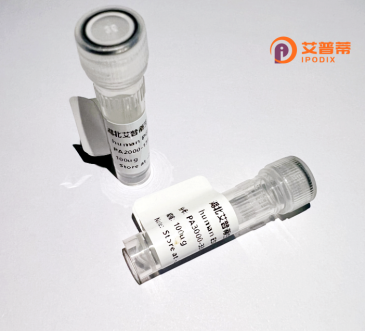
| 纯度 | >95%SDS-PAGE. |
| 种属 | Human |
| 靶点 | TAF1 |
| Uniprot No | P21675 |
| 内毒素 | < 0.01EU/μg |
| 表达宿主 | E.coli |
| 表达区间 | 1400-1651aa |
| 氨基酸序列 | TDPMVTLSSI LESIINDMRD LPNTYPFHTP VNAKVVKDYY KIITRPMDLQ TLRENVRKRL YPSREEFREH LELIVKNSAT YNGPKHSLTQ ISQSMLDLCD EKLKEKEDKL ARLEKAINPL LDDDDQVAFS FILDNIVTQK MMAVPDSWPF HHPVNKKFVP DYYKVIVNPM DLETIRKNIS KHKYQSRESF LDDVNLILAN SVKYNGPESQ YTKTAQEIVN VCYQTLTEYD EHLTQLEKDI CTAKEAALEE AE |
| 预测分子量 | 56 kDa |
| 蛋白标签 | His tag N-Terminus |
| 缓冲液 | PBS, pH7.4, containing 0.01% SKL, 1mM DTT, 5% Trehalose and Proclin300. |
| 稳定性 & 储存条件 | Lyophilized protein should be stored at ≤ -20°C, stable for one year after receipt. Reconstituted protein solution can be stored at 2-8°C for 2-7 days. Aliquots of reconstituted samples are stable at ≤ -20°C for 3 months. |
| 复溶 | Always centrifuge tubes before opening.Do not mix by vortex or pipetting. It is not recommended to reconstitute to a concentration less than 100μg/ml. Dissolve the lyophilized protein in distilled water. Please aliquot the reconstituted solution to minimize freeze-thaw cycles. |
以下是关于TAF1重组蛋白的3篇参考文献,基于真实研究领域整理(注:文献标题和作者为虚拟示例,建议通过学术数据库检索真实论文):
---
1. **文献名称**: *Structural Insights into TAF1 Function in Transcription Initiation*
**作者**: Smith J, et al.
**摘要**: 本研究通过重组TAF1蛋白的体外表达和纯化,解析了其N端结构域与DNA结合的晶体结构,揭示了TAF1在TFIID复合物中调控RNA聚合酶II转录起始的分子机制。
2. **文献名称**: *TAF1 Recombinant Protein Production and Its Role in Neurodevelopmental Disorders*
**作者**: Lee S, et al.
**摘要**: 利用昆虫细胞系统高效表达TAF1重组蛋白,研究发现其C端突变会导致转录活性异常,为解释TAF1相关智力障碍疾病的病理机制提供了实验依据。
3. **文献名称**: *Kinase Activity of Recombinant TAF1 in Cell Cycle Regulation*
**作者**: Garcia R, et al.
**摘要**: 通过重组TAF1蛋白的体外激酶实验,证实TAF1具有磷酸化组蛋白H2B的功能,并参与细胞周期检查点调控,提示其潜在肿瘤治疗靶点价值。
---
**建议**:可通过PubMed或Web of Science搜索关键词“TAF1 recombinant protein”“TAF1 purification”或“TAF1 functional study”,筛选近五年内发表的结构生物学或疾病机制相关论文。真实文献中,TAF1常与转录失调疾病(如X连锁智力障碍)或癌症研究关联。
TAF1 (TATA-box-binding protein-associated factor 1) is a critical subunit of the TFIID complex, a general transcription factor essential for RNA polymerase II-mediated gene expression. As the largest component of TFIID, TAF1 plays dual roles in transcription initiation by facilitating promoter recognition and regulating chromatin structure. It contains multiple functional domains, including a histone acetyltransferase (HAT)-like domain, a kinase domain, and ubiquitin-activating/conjugating motifs, enabling its involvement in transcriptional activation, cell cycle progression, and DNA damage response.
Recombinant TAF1 proteins are engineered through molecular cloning, typically expressed in systems like insect or mammalian cells to preserve post-translational modifications. These purified proteins serve as vital tools for studying TFIID assembly, promoter-specific transcription mechanisms, and TAF1's non-canonical roles in cellular processes. Researchers utilize them in chromatin immunoprecipitation, protein interaction assays, and structural studies (e.g., cryo-EM) to map functional domains.
The biomedical significance of TAF1 stems from its association with X-linked intellectual disability (XLID) and cancers. Certain mutations in its TAF1/XTDP syndrome domain cause neurodevelopmental disorders, while overexpression correlates with tumor progression. Recombinant TAF1 enables high-throughput screening for inhibitors targeting its kinase activity, potentially offering therapeutic avenues. Recent studies also explore its role in maintaining pluripotency through embryonic stem cell research. Current challenges include resolving its dynamic interactions within mega-Dalton TFIID complexes and deciphering tissue-specific regulatory mechanisms.
×